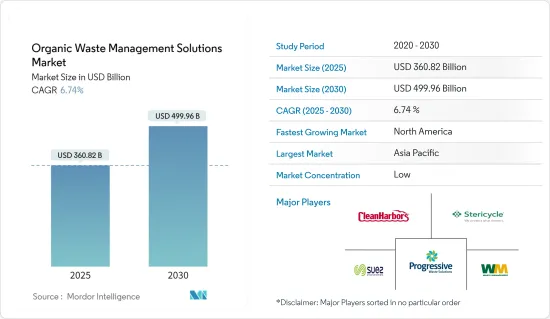
|
시장보고서
상품코드
1636425
유기 폐기물 관리 솔루션 : 시장 점유율 분석, 산업 동향 및 통계, 성장 예측(2025-2030년)Organic Waste Management Solutions - Market Share Analysis, Industry Trends & Statistics, Growth Forecasts (2025 - 2030) |
||||||
유기 폐기물 관리 솔루션의 시장 규모는 2025년에 3,608억 2,000만 달러로 추정되며, 예측 기간(2025-2030년) 동안 6.74%의 CAGR로 2030년에는 4,999억 6,000만 달러에 달할 것으로 예상됩니다.

자연계에서는 주로 유기 폐기물이 발생합니다. 폐기물 관리가 특히 도심에 보급됨에 따라 효과적인 유기 폐기물 관리와 재활용의 필요성이 급증하고 있습니다. 수분을 많이 함유한 도심의 유기 폐기물은 쓰레기를 부피가 커지게 할 뿐만 아니라 온도를 낮춰 소각에 방해가 되기도 합니다. 전 세계적으로 이러한 문제를 해결하기 위해 다양한 처리 방법이 등장하고 있습니다.
환경 친화적인 폐기물 관리를 중시하는 경향이 강해지고 일반 시민들의 환경의식이 높아지면서 유기 폐기물 분야가 큰 폭으로 성장하고 있습니다. 바이오가스 발생장치, 자동 선별 시스템, 혐기성 소화조 등 쓰레기 선별 및 처리 기술의 발전은 유기 폐기물 관리의 효율성을 높이고 있습니다. 유기 폐기물의 효과적인 관리는 환경에 미치는 영향과 온실가스 배출을 억제할 뿐만 아니라 폐기물을 귀중한 자원으로 전환하는 순환 경제를 촉진하는 데에도 매우 중요합니다.
유기 폐기물 관리 솔루션 시장 동향
상업 부문의 친환경 폐기물 관리 솔루션에 대한 수요가 증가
적절한 습식 폐기물 관리가 환경과 건강에 미치는 이점이 인식되면서 쓰레기 수거 및 처리 서비스 개선에 대한 요구가 증가하고 있습니다. 특히, 레스토랑이나 호텔과 같은 접객업 분야의 기업들은 환경 친화적인 전략을 지지하는 폐기물 관리 업체를 적극적으로 찾고 있습니다. 상업 부문의 이러한 인식의 증가는 지속가능한 관행에 대한 관심을 높일 뿐만 아니라 환경에 대한 책임감을 키우고 있습니다.
또한, 바이오가스 생산과 혐기성 소화로 대표되는 폐기물 발전과 같은 노력은 음식물 쓰레기를 귀중한 자원으로 전환하는 지속가능한 길을 보여주고 있습니다. 이러한 방법을 채택하면 매립지 투기를 줄일 수 있을 뿐만 아니라, 유기 폐기물을 재생에너지 생산에 활용할 수 있습니다. 이러한 이중의 이점은 폐기물을 줄이는 데 도움이 될 뿐만 아니라 대체 에너지원에 대한 수요와 환경 보호에도 기여합니다. 그 결과, 상업 시설의 유기 폐기물 관리는 이러한 기술의 지속적인 발전과 경제적, 환경적 이점에 대한 인식이 높아짐에 따라 수요가 급증하고 있습니다.
아시아태평양이 유기 폐기물 관리 시장을 주도할 것으로 전망
향후 몇 년 동안 아시아태평양은 유기 폐기물 관리 시장의 최전선에 서게 될 것으로 예상됩니다. 도시화와 인구의 급격한 증가는 폐기물 발생량의 증가, 특히 가정과 기업에서 발생하는 수분이 많은 폐기물의 증가와 직결되어 있으며, 많은 APAC 국가들은 폐기물 관리 규정을 강화하고 습식 폐기물의 올바른 취급과 처리를 강조하고 있습니다. 이러한 규제는 매립 폐기물을 줄이고 재활용과 퇴비화를 촉진하기 위해 만들어졌습니다. 이 지역은 혁신적 접근 방식에서 벗어나지 않고 대규모 퇴비화 시설과 유기 폐기물의 바이오가스 전환과 같은 시도가 인기를 끌고 있습니다.
아시아태평양의 폐기물 관리 부문은 역량 확대, 신기술 도입, 인프라 강화를 위해 많은 투자가 이루어지고 있습니다. 또한, 지능형 쓰레기통 및 폐기물 추적 시스템과 같은 첨단 기술의 채택도 증가하고 있습니다. 이러한 발전에도 불구하고 아시아태평양은 공급망에서 식품 손실로 인해 어려움을 겪고 있으며, 폐기물 감소 및 지속가능한 식품 이니셔티브를 위한 분명한 기회를 제공하고 있습니다.
유기 폐기물 관리 솔루션 산업 개요
유기 폐기물 관리 솔루션 시장은 세분화되어 있으며, 여러 주요 기업들이 세계 및 지역적으로 사업을 전개하고 있습니다. 이들 기업은 시장에서의 입지를 강화하기 위해 기술 혁신, 파트너십, 사업 확장에 주력하고 있습니다. Waste Management Inc., Clean Harbors Inc., Progressive Waste Solution Ltd., Suez Environment, Stericycle 등이 주요 업체로 꼽힙니다.
기타 혜택
- 엑셀 형식의 시장 예측(ME) 시트
- 3개월간 애널리스트 지원
목차
제1장 소개
- 조사 상정과 시장 정의
- 조사 범위
제2장 조사 방법
제3장 주요 요약
제4장 시장 역학과 인사이트
- 시장 개요
- 시장 성장 촉진요인
- 폐기물 관리를 촉진하는 엄격한 규제와 정책
- 혐기성 소화 기술 채용 증가
- 시장 성장 억제요인
- 매립지의 부족이 시장에 영향
- 복잡한 폐기물 분별과 한정된 인프라
- 시장 기회
- 기술의 진보와 폐기물에서 에너지에 대한 대처
- 민관 협력
- 밸류체인 분석
- 업계의 매력 Porter's Five Forces 분석
- 신규 참여업체의 위협
- 구매자의 교섭력
- 공급 기업의 교섭력
- 대체품의 위협
- 경쟁 기업 간의 경쟁 관계
- 업계의 기술적 진보에 관한 인사이트
- COVID-19의 시장에 대한 영향
제5장 시장 세분화
- 유형별
- 일반 폐기물
- 상업 폐기물
- 산업 폐기물
- 서비스별
- 회수
- 운송
- 재활용과 처분
- 지역별
- 북미
- 미국
- 캐나다
- 기타 북미
- 유럽
- 영국
- 독일
- 프랑스
- 러시아
- 이탈리아
- 스페인
- 기타 유럽
- 아시아태평양
- 인도
- 중국
- 일본
- 호주
- 기타 아시아태평양
- 남미
- 브라질
- 아르헨티나
- 기타 남미
- 중동 및 아프리카
- 아랍에미리트
- 남아프리카공화국
- 기타 중동 및 아프리카
- 북미
제6장 경쟁 구도
- 시장 집중 개요
- 기업 개요
- Waste Management Inc.
- Clean Harbors Inc.
- Progressive Waste Solution Ltd
- Suez Environment
- Stericycle
- Courtenay
- Advanced Disposal
- Covanta
- Hitachi Zosen
- Republic Services*
제7장 향후 시장 동향
제8장 면책사항 및 출판사 소개
KSM 25.02.11The Organic Waste Management Solutions Market size is estimated at USD 360.82 billion in 2025, and is expected to reach USD 499.96 billion by 2030, at a CAGR of 6.74% during the forecast period (2025-2030).

Nature predominantly generates organic waste. As waste management gains traction, especially in urban centers, the need for effective organic waste management and recycling has surged. Urban organic waste, with its high moisture content, not only bulks up garbage but also hampers incineration by lowering temperatures. Globally, a spectrum of treatment methods has emerged to tackle these challenges.
Increasing emphasis on eco-friendly waste management, coupled with rising public environmental consciousness, is fueling significant growth in the organic waste sector. Advancements in garbage sorting and processing technologies, such as biogas generators, automated sorting systems, and anaerobic digesters, are enhancing the efficiency of organic waste management. Effective management of organic waste is crucial not only to curb its environmental impact and greenhouse gas emissions but also to foster a circular economy, transforming waste into valuable resources.
Organic Waste Management Solutions Market Trends
Rising Demand for Eco-friendly Waste Management Solutions in the Commercial Sector
As the environmental and health benefits of proper wet waste management gain recognition, the call for enhanced garbage collection and disposal services amplifies. Notably, businesses in the hospitality sector, including restaurants and hotels, actively seek waste management firms that champion eco-friendly strategies. This heightened awareness in the commercial sector not only spurs interest in sustainable practices but also fosters a sense of environmental responsibility.
Moreover, initiatives like waste-to-energy, exemplified by biogas production and anaerobic digestion, present a sustainable avenue for transforming food waste into valuable resources. By adopting these methods, not only is landfill dumping reduced, but organic waste is also harnessed to generate renewable energy. This dual benefit not only aids in waste reduction but also contributes to the demand for alternative energy sources and environmental conservation. Consequently, organic waste management in commercial establishments witnesses a surge in demand, propelled by the continuous evolution of these technologies and the increasing acknowledgment of their economic and environmental advantages.
Asia-Pacific Poised to Lead Organic Waste Management Market
Forecasted for the coming years, Asia-Pacific stands at the forefront of the organic waste management market. The surge in urbanization and population has directly correlated with a rise in waste generation, notably moist waste from households and businesses. Many APAC nations have bolstered their waste management regulations, emphasizing correct handling and disposal of wet waste. These regulations are crafted to not only reduce landfill waste but also to promote recycling and composting. The region has not shied away from innovative approaches, with endeavors like expansive composting facilities and the conversion of organic waste into biogas gaining traction.
Substantial investments are flowing into the Asia-Pacific waste management sector, earmarked for expanding capacities, adopting new technologies, and bolstering infrastructure. Moreover, the adoption of advanced technologies, like intelligent bins and waste-tracking systems, is rising. Despite its advancements, Asia-Pacific grapples with food losses in its supply chain, presenting a clear opportunity for waste reduction and sustainable food initiatives.
Organic Waste Management Solutions Industry Overview
The organic waste management solutions market is fragmented, with several key players operating globally and regionally. These companies focus on technological innovations, partnerships, and expansions to strengthen their market presence. Some of the major players include Waste Management Inc., Clean Harbors Inc., Progressive Waste Solution Ltd, Suez Environment, and Stericycle.
Additional Benefits:
- The market estimate (ME) sheet in Excel format
- 3 months of analyst support
TABLE OF CONTENTS
1 INTRODUCTION
- 1.1 Study Assumption and Market Definition
- 1.2 Scope of the Study
2 RESEARCH METHODOLOGY
3 EXECUTIVE SUMMARY
4 MARKET DYNAMICS AND INSIGHTS
- 4.1 Market Overview
- 4.2 Market Drivers
- 4.2.1 Stringent Regulations and Policies Promoting Waste Management
- 4.2.2 Increasing Adoption of Anaerobic Digestion Technologies
- 4.3 Market Restraints
- 4.3.1 Shortage of Landfill Locations Affects the Market
- 4.3.2 Complexity Waste Segregation and Limited Infrastructure
- 4.4 Market Opportunities
- 4.4.1 Technology Advancements and Waste-to-Energy Initiatives
- 4.4.2 Collaboration Between Public and Private Sectors
- 4.5 Value Chain Analysis
- 4.6 Industry Attractiveness: Porter's Five Forces Analysis
- 4.6.1 Threat of New Entrants
- 4.6.2 Bargaining Power of Buyers
- 4.6.3 Bargaining Power of Suppliers
- 4.6.4 Threat of Substitutes
- 4.6.5 Intensity of Competitive Rivalry
- 4.7 Insights into Technological Advancements in the Industry
- 4.8 Impact of COVID-19 on the Market
5 MARKET SEGMENTATION
- 5.1 By Type
- 5.1.1 Municipal Waste
- 5.1.2 Commercial Waste
- 5.1.3 Industrial Waste
- 5.2 By Service
- 5.2.1 Collection
- 5.2.2 Transportation
- 5.2.3 Recycling and Disposal
- 5.3 By Geography
- 5.3.1 North America
- 5.3.1.1 United States
- 5.3.1.2 Canada
- 5.3.1.3 Rest of North America
- 5.3.2 Europe
- 5.3.2.1 United Kingdom
- 5.3.2.2 Germany
- 5.3.2.3 France
- 5.3.2.4 Russia
- 5.3.2.5 Italy
- 5.3.2.6 Spain
- 5.3.2.7 Rest of Europe
- 5.3.3 Asia-Pacific
- 5.3.3.1 India
- 5.3.3.2 China
- 5.3.3.3 Japan
- 5.3.3.4 Australia
- 5.3.3.5 Rest of Asia-Pacific
- 5.3.4 South America
- 5.3.4.1 Brazil
- 5.3.4.2 Argentina
- 5.3.4.3 Rest of South America
- 5.3.5 Middle East and Africa
- 5.3.5.1 United Arab Emirates
- 5.3.5.2 South Africa
- 5.3.5.3 Rest of Middle East and Africa
- 5.3.1 North America
6 COMPETITIVE LANDSCAPE
- 6.1 Market Concentration Overview
- 6.2 Company Profiles
- 6.2.1 Waste Management Inc.
- 6.2.2 Clean Harbors Inc.
- 6.2.3 Progressive Waste Solution Ltd
- 6.2.4 Suez Environment
- 6.2.5 Stericycle
- 6.2.6 Courtenay
- 6.2.7 Advanced Disposal
- 6.2.8 Covanta
- 6.2.9 Hitachi Zosen
- 6.2.10 Republic Services*



















